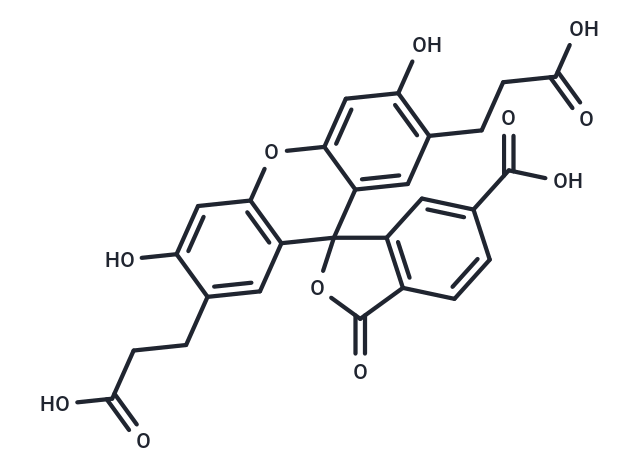Shopping Cart
- Remove All
 Your shopping cart is currently empty
Your shopping cart is currently empty

BCECF is a pH-sensitive fluorescent dye and a cytosolic pH indicator. It can be used for detecting intracellular pH levels.

| Pack Size | Price | Availability | Quantity |
|---|---|---|---|
| 1 mg | $95 | In Stock | |
| 5 mg | Inquiry | 35 days |
| Description | BCECF is a pH-sensitive fluorescent dye and a cytosolic pH indicator. It can be used for detecting intracellular pH levels. |
| In vitro | Methods: 1. 2-20mM BCECF mother liquor was prepared in anhydrous DMSO. 2. Use Hanks or PBS to prepare 5-50µM BCECF dye. 3. Add the configured BCECF dye to the cell culture plate. 1000 μL/well (6-well plate),100 μL/well (96-well plate) or 25 μL/well (384-well plate). 4, Use a fluorescence microscope or fluorescent plate reader to measure at Ex/Em = 490/535 nm or 430/535 nm. Results: The new use of BCECF as a fluorescent marker for hydrogen bodies (the first such marker) was demonstrated. |
| Alias | 2',7'-Bis(2-carboxyethyl)-5(6)-carboxyfluorescein |
| Molecular Weight | 520.44 |
| Formula | C54H40O22 |
| Cas No. | 85138-49-4 |
| Smiles | O=C(O1)C2=C(C=C(C(O)=O)C=C2)C31C4=C(C=C(O)C(CCC(O)=O)=C4)OC5=CC(O)=C(CCC(O)=O)C=C53 O=C(O1)C2=C(C=CC(C(O)=O)=C2)C31C4=C(C=C(O)C(CCC(O)=O)=C4)OC5=CC(O)=C(CCC(O)=O)C=C53 |
| Relative Density. | 1.67g/cm3 |
| Storage | keep away from direct sunlight,store at low temperature | Powder: -20°C for 3 years | In solvent: -80°C for 1 year | Shipping with blue ice. | ||||||||||||||||||||||||||||||
| Solubility Information | H2O: < 0.1 mg/mL (insoluble) DMSO: 50.00 mg/mL (96.07 mM), Sonication is recommended. | ||||||||||||||||||||||||||||||
Solution Preparation Table | |||||||||||||||||||||||||||||||
DMSO
| |||||||||||||||||||||||||||||||

Copyright © 2015-2025 TargetMol Chemicals Inc. All Rights Reserved.